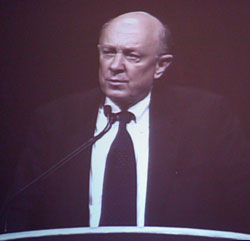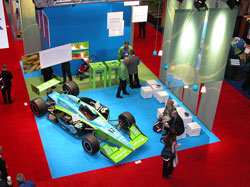Analysts are saying that the US will be importing more ethanol this summer to keep up with demand caused by the phase-out of MTBE. According to a Dow Jones story,
U.S. cane-based ethanol imports are expected to more than double in 2006 from 511 million liters in 2005. “Moving U.S. ethanol, produced in the heartlands, to population centers on the coasts, where demand is heaviest, is a logistical challenge,” said Edward Murphy, downstream general manager of the American Petroleum Institute in Washington. “Because ethanol absorbs water and corrodes pipelines, it must be trucked or moved by rail to consumption areas for final blending.” More tanks are needed to store and blend ethanol on the East Coast, where it’s difficult and expensive to construct them. Imports, however, have the advantage of arriving at major population centers.
In other words, the petroleum industry is contending that it’s easier to import ethanol than it is to truck it from the midwest. Not sure I believe that.
The article also notes that with the increased demand – guess what? – the price of Brazilian ethanol is going up. It’s also significant to note that while there is a tariff on ethanol imports from Brazil, the Caribbean Basin Initiative allows a limited amount of ethanol to come in duty free from 24 nations. So, the call to lift the tariff on foreign ethanol is being sounded by lawmakers. One is Connecticut Governor Jodie Rell, who is asking her state’s congressional delegation to support lifting the tariff to provide “much needed relief” from rising gas prices, according to an AP report.
I think it makes good political sense to lift the tariff, at least temporarily, to help with the short supply situation here – but I have serious doubts that it will provide any relief from rising gas prices since it’s as good as any excuse to raise gas prices.
 Ethanol plants are popping up like prarie dogs in Nebraska.
Ethanol plants are popping up like prarie dogs in Nebraska. 

 The plenary breakfast speaker today, R. James Woolsey, Vice President, Booz Allen Hamilton, Former Director of the Central Intelligence Agency, just finished speaking. He really focused on how biotechnology can play a role in our national security. Besides what most people probably think of first in terms of cures or innoculants for bio-terror induced disease he spent a while talking about energy and independence from terrorist controlled foreign oil.
The plenary breakfast speaker today, R. James Woolsey, Vice President, Booz Allen Hamilton, Former Director of the Central Intelligence Agency, just finished speaking. He really focused on how biotechnology can play a role in our national security. Besides what most people probably think of first in terms of cures or innoculants for bio-terror induced disease he spent a while talking about energy and independence from terrorist controlled foreign oil.

 Illinois farmer, banker, ethanol plant CEO and RFA board member Ray Defenbaugh was one of several people who spoke to a group of visiting agricultural journalists during a media reception sponsored by the
Illinois farmer, banker, ethanol plant CEO and RFA board member Ray Defenbaugh was one of several people who spoke to a group of visiting agricultural journalists during a media reception sponsored by the  The media has been sounding the alarm about higher gas prices today, following the release of the
The media has been sounding the alarm about higher gas prices today, following the release of the  The latest “Fill Up, Feel Good” podcast from the
The latest “Fill Up, Feel Good” podcast from the  It wasn’t real easy but I was able to ask llinois Governor,
It wasn’t real easy but I was able to ask llinois Governor,  The #17 Team Ethanol car is on display here at BIO 2006 in the
The #17 Team Ethanol car is on display here at BIO 2006 in the  Auto news site
Auto news site  Beginning late Sunday I’ll be blogging the
Beginning late Sunday I’ll be blogging the